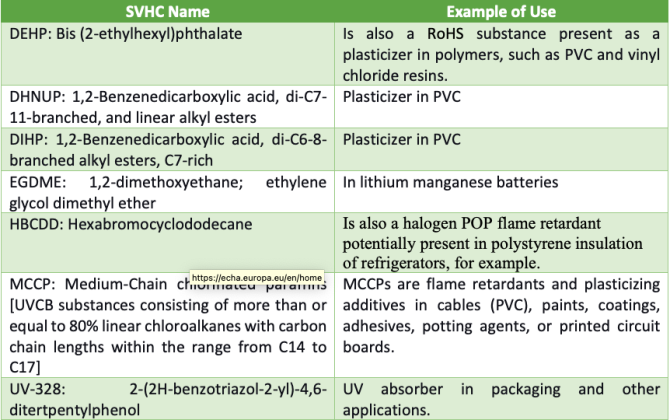
REACHing environmental laws
By Aury Hathout, certified environmental auditor, Enviropass Expertise Inc.
Electronics Production / Materials Engineering Environmental Supply Chain environmentalEU releases its latest Substances of Very High Concern
You may have heard about the famous restrictions of hazardous substances in electrical and electronic equipment (RoHS). The REACH regulation is another European environmental law that directly impacts producers and importers. Every six months, the European Union (EU) lists so-called Substances of Very High Concern (SVHCs) under REACH. We will briefly present the REACH applicable requirements and the latest list of 223 REACH SVHCs.
What is EU REACH?
First of all, let’s summarize the REACH regulation. Within the European Union (EU), all manufacturers, importers, and downstream users must comply with this law known as the Registration, Evaluation, Authorization, and Restriction of Chemicals regulation 1907/2006. According to the European Chemicals Agency (ECHA), this regulation aims to “improve the protection of human health and the environment from the risks that can be posed by chemicals, while enhancing the competitiveness of the EU chemicals industry”. The requirements in question include hazardous substances commonly used in electronics, like the Medium-Chain Chlorinated Paraffins (MCCP) in plastics. Applicable to articles producers (i.e., physical products), we can find REACH restrictions under Annex XVII) and obligations to declare SVHCs.
The REACH Annex XVII
The REACH regulation includes Annex XVII, with pure substances restrictions in various applications. Few of these conditions directly impact electronic devices, like nickel and compounds that are not allowed when intended to come into direct and prolonged contact with the skin. For example, a button, a handle, or a viewfinder may bear prohibited nickel finishes. Importantly, amendments regularly add new restrictions to Annex XVII.
The REACH SVHC List
The SVHC list is another crucial inventory of hazardous materials that companies need to monitor. Indeed, some SVHCs are considered carcinogenic, mutagenic, or toxic for reproduction (CMR). Other SVHCs can cause environmental wreckages by being persistent, bioaccumulative, and toxic (PBT).
Consequently, if a component of an electronic assembly contains an SVHC at a concentration of 0.1% or more (weight by weight), producers must inform downstream users. To that end, customers have a right to ask a supplier whether a product contains SVHCs.
SVHCs in Electronics
Undoubtedly, the SVHC list heavily impacts the electronics sector. For instance, you can find in this table some SVHCs present in electronic applications:

Table 1
223 SVHCs
Every six months, the SVHC list contains new chemicals. Consequently, as of January 17, 2022, four new high-risk substances have been added to the SVHC list. Therefore, there are now 223 SVHC entries. Here are the additional four new SVHCs:
- 4-MBC
- DBMC
- S-(tricyclo[5.2.1.0’2,6]deca-3-en-8(or 9)-yl) O-(isopropyl or isobutyl or 2-ethylhexyl) O-(isopropyl or isobutyl or 2-ethylhexyl) phosphorodithioate
- Tris(2-methoxyethoxy)vinylsilane
New SVHCs Present in the Electronic Industry
Some of the new SVHCs above affect applications in the electronic industry. Here are examples:

Table 2: Interestingly, ECHA publishes insightful studies and resources to know better SVHCs.
SCIP Database for SVHC Notifications
Because of article 33 REACH regulation 1907/2006, suppliers must “communicate information on substances in articles.”
Therefore, since early 2021, ECHA has implemented the so-called SCIP (Substances of Concern In Products) database to help the communication of SVHCs. On the SCIP database, we can access millions of declarations of products with at least one declarable SVHC.
Critically, SCIP notifications are mandatory. The obligation to communicate SVHCs impacts both consumer and professional products. Consequently, if an article is not present on the list, one can assume that not declarable SVHCs are present.
How to comply with REACH SVHCs
In other words, how could the frequent addition of substances affect existing and developing products? Sadly, the periodic updates of the SVHC list can cause legal issues to many companies. Fortunately, it is possible to comply pragmatically. Here are some hints to implement an environmental product compliance management system and demonstrate due diligence. It is the MACC environmental compliance approach:
- Monitor the applicable requirements. Companies need to regularly verify the status of both REACH Annex XVII and the SVHC list. Additionally, producers must confirm that their existing or developing products are not concerned with the changes. If they are, then actions 2 to 4 apply.
- Assess your product against the new requirements. Since you cannot verify every material against all controlled substances, you need to perform risks assessments. Standards can help you adopt the best-recognized methods. Documentary reviews and, at last resort, analytical testing (chemical analysis) are the two common approaches. You will most likely have to audit your supply chains.
- Correct any risk of non-compliance in your products.
- Communicate product compliance to third parties via declarations of conformity, the SCIP database, etc.
Finally, do not hesitate to ask experts around you who can advise you and help you find the best strategy through customized solutions.
——————————————————
